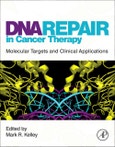Cancer therapeutics include an ever-increasing array of tools at the disposal of clinicians in their treatment of this disease. However, cancer is a tough opponent in this battle, and current treatments, which typically include radiotherapy, chemotherapy and surgery, are not often enough to rid the patient of his or her cancer. Cancer cells can become resistant to the treatments directed at them, and overcoming this drug resistance is an important research focus. Additionally, increasing discussion and research is centering on targeted and individualized therapy. While a number of approaches have undergone intensive and close scrutiny as potential approaches to treat and kill cancer (signaling pathways, multidrug resistance, cell cycle checkpoints, anti-angiogenesis, etc.), other approaches have focused on blocking the ability of a cancer cell to recognize and repair the damaged DNA that primarily results from the front-line cancer treatments; chemotherapy and radiation.
This comprehensive and timely reference focuses on the translational and clinical use of DNA repair as a target area for the development of diagnostic biomarkers and the enhancement of cancer treatment.
- Saves academic, medical, and pharmaceutical researchers time in quickly accessing the very latest details on DNA repair and cancer therapy, as opposed to searching through thousands of journal articles
- Provides a common language for cancer researchers, oncologists, and radiation oncologists to discuss their understanding of new molecular pathways, clinical targets, and anti-cancer drug development
- Provides content for researchers and research clinicians to understand the importance of the breakthroughs that are contributing to advances in disease-specific research
Table of Contents
1. Introduction and Overview of Current Targets: Bench to Clinic
Mark R. Kelley
2. MGMT a Critical DNA Repair Gene Target for Chemotherapy Resistance
Stanton L. Gerson and Lili Liu
3. Blockade of Base Excision Repair: Inhibitionof Small Lesions Results in Big Consequences to Cancer Cells
Melissa Fishel and Carlo Vascotto
4. PARP Inhibitors Scientific Rationale and Clinical Development for Cancer
Ruth Plummer, Nicola J. Curtin and Yvette Drew
5. Inhibiting Selective DNA Polymerases for Therapeutic Intervention
Anthony J. Berdis
6. Targeting the Nucleotide Excision Repair Pathway for Therapeutic Applications
John Turchi and Stephan M. Patrick
7. Homologous Recombination and ATM/ATR Targets
Henning Willers, Lee Zou and Heike N. Pfaffle
8. DNA Double Strand Break Repair by Nonhomologous End Joining and its Clinical Relevance
Michael Weinfeld and Susan Lees-Miller
9. Defective MMR-c-Abl-p73-GADD45alpha Expression in Cancer Chemoresistance
David Boothman and Long Shan Li
10. DNA Repair Signaling Targets
Susan Ashwell
11. Redox Regulation of DNA Repair and Therapeutic
Millie M. Georgiadis
12. Personalized Cancer Medicine: DNA Repair Alterations is a Promising Predictive Marker in Cancer
Srinivasan Madhusudan
13. The Role of DNA Damage and Repair in Neurotoxicity Caused by Cancer Therapies
Michael R. Vasko
14. Future Directions
Mark R. Kelley








